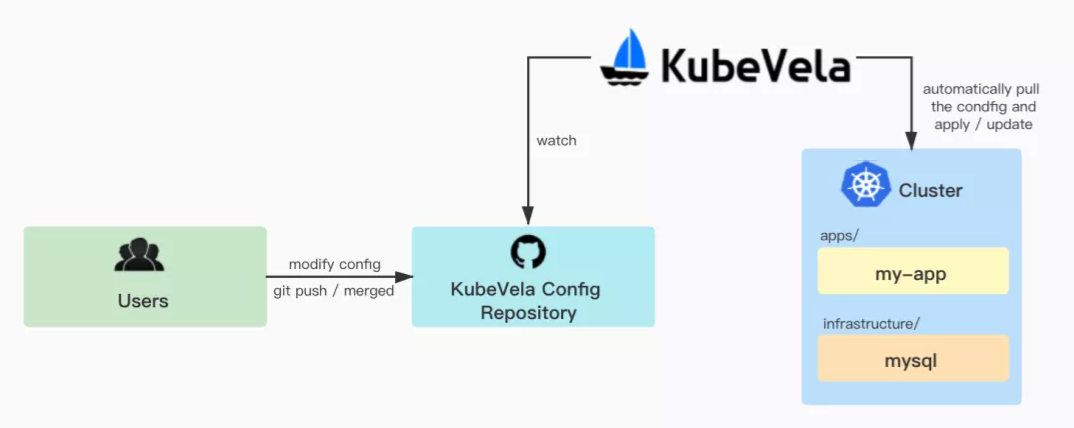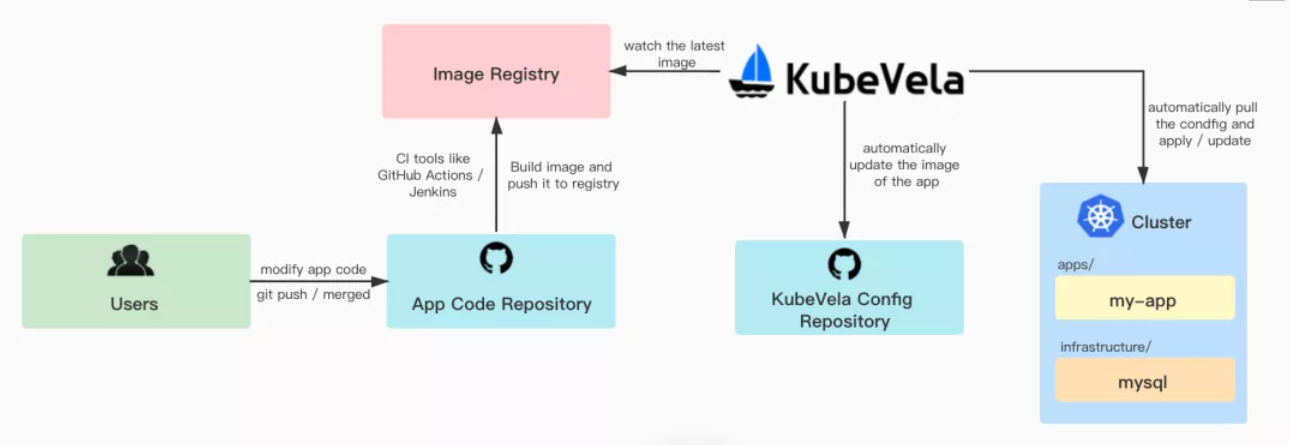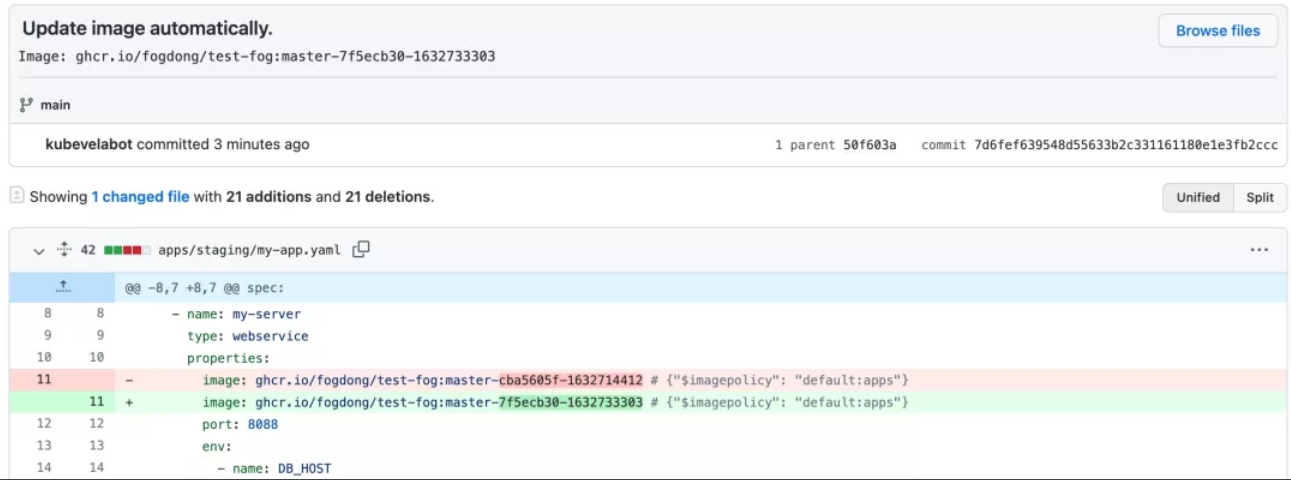By Dong Tianxin (Wuwu)
Auditing & Proofreading by Xiyang, Haizhu
KubeVela is a simple, easy-to-use, highly scalable cloud-native application management and delivery platform. It enables developers to define and deliver modern microservice applications on Kubernetes without knowing the details related to the Kubernetes infrastructure.
The OAM model behind KubeVela solves management problems, such as the combination and orchestration of complex resources during application building. It also sets a model for later O&M strategies. This means KubeVela can manage complex large-scale applications in combination with GitOps and simplify system complexity caused by team and system scale growth.
The core idea of GitOps is to store the basic architecture and declarative description of the application configuration required by the application system in the Git warehouse and cooperate with an automated process. This way, the automated process can update the environment to the latest configuration each time the warehouse is updated.
This method allows developers to automatically deploy applications by changing the code and configuration in the Git warehouse. GitOps can bring the following advantages to application development:
KubeVela, as a declarative application delivery and control plane, natively supports GitOps. It enables users to experience end-to-end application delivery and management and enjoy the following benefits brought by GitOps:
Application delivery workflow (CD pipeline)
This article describes the steps of using KubeVela to deliver in GitOps mode.
GitOps workflow consists of CI (Continuous Integration) and CD (Continuous Delivery):
Applications are delivered to the following two types of personnel:
In the following figure, platform administrators/O&M personnel do not need to know the application code. They only need to prepare a Git configuration repository and deploy KubeVela configuration files. Subsequent configuration modifications of applications and infrastructure can be completed by updating the Git configuration repository. This makes each configuration modification traceable.

Please see Sample Repository 1 for specific configuration via the related links at the end of this article.
In this example, we deploy MySQL database software as the infrastructure of the project and a business application to use this database. The sample directory structure of the configuration repository contains the following elements:
clusters/ contains the KubeVela GitOps configuration in the cluster. You need to manually deploy the files in clusters/ to the cluster. This is a one-time control operation. After the operation is performed, KubeVela automatically listens to file modifications in the configuration repository and updates the configurations in the cluster. The clusters/apps.yaml file listens to modifications in all applications in the apps/ directory, while the clusters/infra.yaml file listens to modifications in all infrastructures in the infrastructure/ directory.apps/ directory contains all the configurations of the business application. In this example, it is a business application that uses the database.infrastructure/ directory contains infrastructure-related configurations and policies. In this example, the infrastructure is the MySQL database.├── apps
│ └── my-app.yaml
├── clusters
│ ├── apps.yaml
│ └── infra.yaml
└── infrastructure
└── mysql.yamlKubeVela recommends using the preceding directory structure to manage your GitOps repository. You can use the clusters/ directory to store related KubeVela GitOps configurations and manually deploy the configurations to the cluster. Use the apps/ directory and the infrastructure/ directory to store your application and infrastructure configurations. You can manage your deployment environment properly and isolate the impact of application changes by separating the application configuration from the infrastructure configuration.
clusters/ directoryThe clusters directory is also the configuration directory of the initialization operation for KubeVela to connect to GitOps.
Take clusters/infra.yaml as an example:
apiVersion: core.oam.dev/v1beta1
kind: Application
metadata:
name: infra
spec:
components:
- name: database-config
type: kustomize
properties:
repoType: git
# replace this url with the address of the git configuration repository that you want to listen to
url: https://github.com/FogDong/KubeVela-GitOps-Infra-Demo
# If it is a private repository that you want to listen to, you must associate the url with a git secret.
# secretRef: git-secret
# The time interval for automatically pulling configuration. Because the infrastructure is usually slightly modified, set this parameter to 10 minutes.
pullInterval: 10m
git:
# listen to the modified branch
branch: main
# listen to the modified path, and the path points to the files in the infrastructure directory in the repository
path: ./infrastructureapps. Yaml and infra.yaml are almost the same, but they listen to different file directories. In apps.yaml, the value of properties.path is set to ./apps, indicating that file modifications in the apps/ directory are listened to. The GitOps control configuration file in the
cluster folder must be manually deployed to the cluster at one time during initialization. After that, KubeVela automatically listens to the configuration files in the apps/ and infrastructure/ directories and updates and synchronizes them regularly.
The apps/ directory stores application configuration files, which is a simple application configured with database information and Ingress. The application connects to a MySQL database and starts the service. In the default service path, the current version number is displayed. In the /db path, the information in the current database is listed.
apiVersion: core.oam.dev/v1beta1
kind: Application
metadata:
name: my-app
namespace: default
spec:
components:
- name: my-server
type: webservice
properties:
image: ghcr.io/fogdong/test-fog:master-cba5605f-1632714412
port: 8088
env:
- name: DB_HOST
value: mysql-cluster-mysql.default.svc.cluster.local:3306
- name: DB_PASSWORD
valueFrom:
secretKeyRef:
name: mysql-secret
key: ROOT_PASSWORD
traits:
- type: ingress
properties:
domain: testsvc.example.com
http:
/: 8088This application uses the webservice of the built-in component type of KubeVela. It is bound with Ingress O&M features. By declaring O&M capabilities in the application, you can collect the underlying Deployment, Service, and Ingress by using only one file. This facilitates easier application management.
infrastructure/ directoryThe infrastructure/ directory stores infrastructure configurations. Here, we use a MySQL controller to deploy a MySQL cluster. (Please see the related links at the end of this article.)
Make sure you have a secret in your cluster and declare the MySQL password through ROOT_PASSWORD.
apiVersion: core.oam.dev/v1beta1
kind: Application
metadata:
name: mysql
namespace: default
spec:
components:
- name: mysql-controller
type: helm
properties:
repoType: helm
url: https://presslabs.github.io/charts
chart: mysql-operator
version: "0.4.0"
- name: mysql-cluster
type: raw
dependsOn:
- mysql-controller
properties:
apiVersion: mysql.presslabs.org/v1alpha1
kind: MysqlCluster
metadata:
name: mysql-cluster
spec:
replicas: 1
# associate the name of the secret
secretName: mysql-secretIn the preceding sample MySQL application, the capabilities of the KubeVela workflow are used. The workflow is divided into two steps. The first step deploys the MySQL controller. After the controller is deployed and running properly, the second step deploys the MySQL cluster.
Deploy files in the clusters/ directory
After the files above are configured and stored in the Git configuration repository, you need to manually deploy the KubeVela GitOps configuration file in the clusters/ directory in the cluster.
First, deploy clusters/infra.yaml in the cluster. It automatically pulls up the MySQL deployment files in the infrastructure/ directory in the cluster.
kubectl apply -f clusters/infra.yaml$ vela ls
APP COMPONENT TYPE TRAITS PHASE HEALTHY STATUS CREATED-TIME
infra database-config kustomize running healthy 2021-09-26 20:48:09 +0800 CST
mysql mysql-controller helm running healthy 2021-09-26 20:48:11 +0800 CST
└─ mysql-cluster raw running healthy 2021-09-26 20:48:11 +0800 CSTThen, deploy clusters/apps.yaml in the cluster. It automatically pulls up the application deployment files in the apps/ directory.
kubectl apply -f clusters/apps.yamlAPP COMPONENT TYPE TRAITS PHASE HEALTHY STATUS CREATED-TIME
apps apps kustomize running healthy 2021-09-27 16:55:53 +0800 CST
infra database-config kustomize running healthy 2021-09-26 20:48:09 +0800 CST
my-app my-server webservice ingress running healthy 2021-09-27 16:55:55 +0800 CST
mysql mysql-controller helm running healthy 2021-09-26 20:48:11 +0800 CST
└─ mysql-cluster raw running healthy 2021-09-26 20:48:11 +0800 CSTApplications and databases are automatically pulled up in the cluster by the deployment of the KubeVela GitOps configuration file.
The Ingress of curl shows that the current version is 0.1.5, and the application is connected to the database.
$ kubectl get ingress
NAME CLASS HOSTS ADDRESS PORTS AGE
my-server <none> testsvc.example.com <ingress-ip> 80 162m
$ curl -H "Host:testsvc.example.com" http://<ingress-ip>
Version: 0.1.5
$ curl -H "Host:testsvc.example.com" http://<ingress-ip>/db
User: KubeVela
Description: It's a test userAfter the first deployment, you can update the configurations of applications in the cluster by modifying the configurations in the configuration repository.
The following code modifies the Domain of the application Ingress:
...
traits:
- type: ingress
properties:
domain: kubevela.example.com
http:
/: 8089The following code shows the information about Ingress in the cluster after a while:
NAME CLASS HOSTS ADDRESS PORTS AGE
my-server <none> kubevela.example.com <ingress-ip> 80 162mThe Host address of Ingress has been updated.
This way, you can automatically update the configurations in a cluster with ease by updating the files in the Git configuration repository.
End developers need an application code repository in addition to the KubeVela Git configuration repository. In the following figure, after the code in the application code repository is updated, a CI needs to be configured to automatically build and push images to the image repository. KubeVela listens to the latest images in the image repository, automatically updates the image configurations in the configuration repository, and updates the application configurations in the cluster. This enables the configurations in the cluster to be automatically updated after the code is updated.

Prepare a code repository that contains source code and the corresponding Dockerfile
The code connects to a MySQL database and starts the service. The current version number is displayed in the default service path. In the /db path, the information in the current database is listed.
http.HandleFunc("/", func(w http.ResponseWriter, r *http.Request) {
_, _ = fmt.Fprintf(w, "Version: %s\n", VERSION)
})
http.HandleFunc("/db", func(w http.ResponseWriter, r *http.Request) {
rows, err := db.Query("select * from userinfo;")
if err != nil {
_, _ = fmt.Fprintf(w, "Error: %v\n", err)
}
for rows.Next() {
var username string
var desc string
err = rows.Scan(&username, &desc)
if err != nil {
_, _ = fmt.Fprintf(w, "Scan Error: %v\n", err)
}
_, _ = fmt.Fprintf(w, "User: %s \nDescription: %s\n\n", username, desc)
}
})
if err := http.ListenAndServe(":8088", nil); err != nil {
panic(err.Error())
}We hope that after the user modifies the code and submits it, the latest image is automatically built and pushed to the image repository. You can use GitHub Actions, Jenkins, or other CI tools to realize continuous integration. In this example, we use GitHub Actions. Please see Sample Repository 2 for more information about code files and configurations via the related links at the end of this article.
After a new image is pushed to the image repository, KubeVela identifies the new image and updates the application configuration files in the repository and the cluster. Therefore, we need a Secret that contains Git information to enable KubeVela to submit to the Git repository. Deploy the following file and replace the username and password with your Git username and password (or Token):
apiVersion: v1
kind: Secret
metadata:
name: git-secret
type: kubernetes.io/basic-auth
stringData:
username: <your username>
password: <your password>The configuration repository is similar to the repository for O&M personnel. You only need to add the configurations related to the image repository. Please see Sample Repository 1 for specific configurations via the related links at the end of this article.
Modify apps.yaml in the clusters/ directory. This GitOps configuration listens to application file modifications in the apps/ directory in the repository and image updates in the image repository:
...
imageRepository:
# The URL of the image
image: <your image>
# If the image repository is a private one, you can create the corresponding image key and associate the key to the repository by using kubectl create secret docker-registry.
# secretRef: imagesecret
filterTags:
# Support filtering by image tags.
pattern: '^master-[a-f0-9]+-(?P<ts>[0-9]+)'
extract: '$ts'
# filter the latest image tags by using a policy and update the image
policy:
numerical:
order: asc
# append submission information
commitMessage: "Image: {{range .Updated.Images}}{{println .}}{{end}}"Modify the image field in apps/my-app.yaml and add the comment # {"$imagepolicy": "default:apps"}. KubeVela uses this comment to update the corresponding image fields. default:apps is the namespace and name corresponding to the preceding GitOps configuration.
spec:
components:
- name: my-server
type: webservice
properties:
image: ghcr.io/fogdong/test-fog:master-cba5605f-1632714412 # {"$imagepolicy": "default:apps"}After you update the files that contain the image repository configurations in the clusters/ directory to the cluster, you can update the application by modifying the code.
Change the version in the code file to 0.1.6 and modify data in the database:
const VERSION = "0.1.6"
...
func InsertInitData(db *sql.DB) {
stmt, err := db.Prepare(insertInitData)
if err != nil {
panic(err)
}
defer stmt.Close()
_, err = stmt.Exec("KubeVela2", "It's another test user")
if err != nil {
panic(err)
}
}Submit the modification to the code repository. The CI pipeline you configure starts to build images and pushes them to the image repository.
KubeVela listens to the image repository and updates the application my-app in the apps/ directory in the configuration repository based on the latest image tag.
In the process, kubevelabot has a commit in the configuration repository, and the commit information is prefixed with Update image automatically. You can also use {{range .Updated.Images}}{{println .}}{{end}} to append the information that you need to the commitMessage field.

Note: If you want to put the code and the configuration in the same repository, you need to filter out commits from kubevelabot to prevent the repeated building of the pipeline. You can achieve that by using the following configuration in CI:
jobs:
publish:
if: "!contains(github.event.head_commit.message, 'Update image automatically')"If you check the application in the cluster again, the image of the application my-app has been updated.
KubeVela obtains the latest information from the configuration repository and the image repository at regular intervals based on the specified interval.
Use the Ingress corresponding to curl to view the current version and database information:
$ kubectl get ingress
NAME CLASS HOSTS ADDRESS PORTS AGE
my-server <none> kubevela.example.com <ingress-ip> 80 162m
$ curl -H "Host:kubevela.example.com" http://<ingress-ip>
Version: 0.1.6
$ curl -H "Host:kubevela.example.com" http://<ingress-ip>/db
User: KubeVela
Description: It's a test user
User: KubeVela2
Description: It's another test userThe version has been updated successfully. We have performed all the operations required, from changing the code to automatic deployment to the cluster.
On the O&M side, if you need to update the configurations of an infrastructure (such as the database) or the configuration items of an application, you only need to modify the files in the configuration repository. KubeVela automatically synchronizes the configurations to the cluster. The deployment process is simplified.
On the R&D side, after you modify the code in the code repository, KubeVela automatically updates the image in the configuration repository. Then, the version updates of an application are facilitated.
KubeVela accelerates the entire process from development to deployment of applications through a combination with GitOps.
Istio-Based Exploration and the Practice of the Comprehensive-Procedure Canary Solution

514 posts | 50 followers
FollowAlibaba Developer - June 21, 2021
Alibaba Cloud Native Community - April 4, 2023
Alibaba Container Service - May 16, 2024
Alibaba Container Service - December 19, 2024
Alibaba Container Service - May 31, 2023
Alibaba Container Service - July 16, 2024

514 posts | 50 followers
Follow Alibaba Cloud Flow
Alibaba Cloud Flow
An enterprise-level continuous delivery tool.
Learn More Bastionhost
Bastionhost
A unified, efficient, and secure platform that provides cloud-based O&M, access control, and operation audit.
Learn More Managed Service for Grafana
Managed Service for Grafana
Managed Service for Grafana displays a large amount of data in real time to provide an overview of business and O&M monitoring.
Learn More DevOps Solution
DevOps Solution
Accelerate software development and delivery by integrating DevOps with the cloud
Learn MoreMore Posts by Alibaba Cloud Native Community